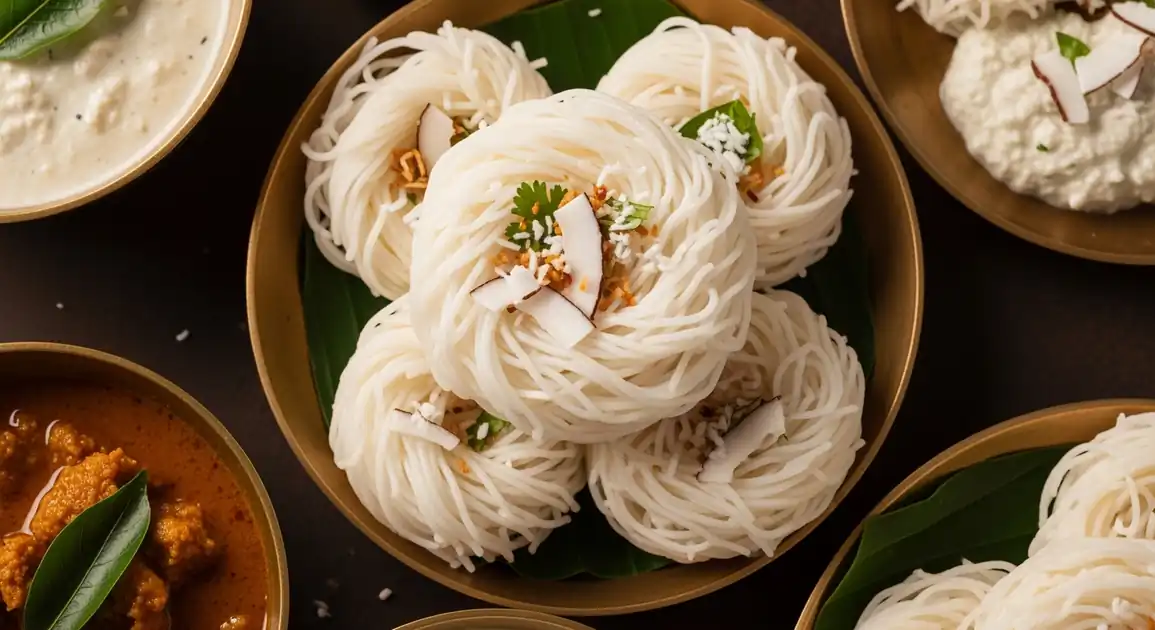Idiyappam (String Hoppers)
ඉඩියාප්පම් (Sinhala) / இடியாப்பம் (Tamil)

Description
Colombo offers the widest variety of idiyappam experiences in Sri Lanka, from humble street-side kades to upscale restaurants reimagining this traditional breakfast. As the cosmopolitan capital, Colombo's idiyappam scene reflects both Sinhalese and Tamil traditions, plus innovative fusion approaches. The best versions maintain traditional techniques while using quality ingredients, served with perfectly prepared accompaniments.
Dietary Information
Serving information
Serving style
Local places serve on banana leaves or basic plates; upscale establishments use ceramic plateware with artfully arranged accompaniments. Tamil restaurants often provide more accompaniment options.
Quick facts
Small kades: 6 AM - 10 AM and sometimes 6 PM - 9 PM. Restaurants: 7 AM - 10 PM. Hotel buffets: 6:30 AM - 10:30 AM for breakfast.
Safety Tips
What to Look For
-
Freshly steamed idiyappam with visible steam
Freshly steamed string hoppers minimize food safety concerns and offer the best texture. Look for places where you can see them being prepared or where steam is still visible from recently made batches.
-
Clean, dedicated idiyappam-making area
Establishments with a specific, clean preparation area for idiyappam typically take more care with the process and ingredients.
-
Properly stored accompaniments (curries, sambols)
While idiyappam itself is low-risk, accompaniments like curries need to be kept at safe temperatures. Avoid places where curries sit at room temperature for extended periods.
-
White or slightly off-white color with distinct strands
Quality idiyappam should be clean-looking with visible separate strands, indicating proper preparation and freshness.
-
Venues with high turnover of customers
Busy establishments typically prepare food more frequently, ensuring freshness.
What to avoid
-
Grayish, discolored, or yellowed idiyappam
Discoloration suggests old rice flour, poor storage, or idiyappam that was made long ago and has been sitting out.
-
Clumpy, mushy texture without distinct strands
Indicates either poor preparation or idiyappam that has been sitting too long and absorbed moisture from the air.
-
Sour or musty smell
Fresh idiyappam should have a neutral or slightly sweet rice aroma. Any sour smell suggests fermentation has begun, especially in tropical climates.
-
Pre-made idiyappam sitting uncovered for long periods
Exposed idiyappam can collect dust and contaminants. Prefer places that make them fresh or keep them covered.
-
Lukewarm curries that should be hot
Accompaniments like curry should be kept hot to prevent bacterial growth. Cold sambols (like pol sambol) should look fresh and vibrant.
Price information
Price range
Budget tips
- Local restaurants in Pettah and Wellawatte offer economical options (100-200 LKR).
- Mid-range restaurants in Bambalapitiya and Kollupitiya charge 200-350 LKR.
- High-end hotels and specialty restaurants may charge 350-500 LKR for gourmet presentations.
- Manning Market area has affordable breakfast vendors with freshly made idiyappam.
- Hotel buffets often include idiyappam but at premium prices hidden in the buffet cost.
Value indicators
- Made fresh to order rather than prepared in advance.
- Accompaniments made in-house rather than from commercial preparations.
- Hand-pressed idiyappam (rather than machine-made) often indicates greater attention to craft.
- Distinct, separate strands that hold together when picked up.
- Generous portions of accompaniments included in the price.
Where to Find This Dish
Wellawatte
Colombo's 'Little Jaffna' has numerous Tamil restaurants serving excellent idiyappam with authentic accompaniments.
Wellawatte Market, Galle Road stretch, Ramakrishna Road
Morning, Evening
Pettah
The bustling market area has local kades serving economical, authentic idiyappam to workers and shoppers.
Manning Market, Main Street area
Early Morning, Morning
Bambalapitiya
Mix of traditional and more upscale establishments serving refined versions.
Galle Road, Marine Drive
Morning
Kollupitiya
Home to some specialty Sri Lankan restaurants that serve higher-end interpretations.
Liberty Plaza area, Duplication Road
Morning
Vendor Tips
- Tamil restaurants often specialize in the best idiyappam - look for places with 'South Indian and Sri Lankan cuisine' signs.
- Some small places make only limited batches - arriving early ensures freshness and availability.
- Hotels serving idiyappam often make large batches - ask when they were prepared.
- Specialty breakfast places like Upali's, Green Cabin, or Palmyrah offer good quality with multiple accompaniments.
How to Order
Regional Variations
-
Kottu Idiyappam
(Kottu Idiyappam)
A Colombo fusion creation where idiyappam is chopped and stir-fried with spices and protein, similar to the popular kottu roti.
-
Upscale Idiyappam
(Premium Idiyappam)
High-end restaurants in Colombo serve idiyappam with gourmet curries and elegant presentations, sometimes incorporating non-traditional ingredients like truffle oil or seafood.
-
Hotel Buffet Style
(Buffet Idiyappam)
Hotels in Colombo typically offer idiyappam at breakfast buffets with both traditional and international accompaniments, catering to tourists.
Cultural context
History
Idiyappam's origins trace back several centuries in South Asian culinary history, with strong connections to both Tamil and Sinhalese cuisines. The dish demonstrates the historical rice cultivation importance in Sri Lanka and the ingenious ways rice was transformed into varied textures and forms. While similar to South Indian idiyappam, Sri Lankan versions typically use distinctive accompaniments like kiri hodi (coconut milk curry) and pol sambol that reflect the island's unique culinary heritage. The preparation method using special idiyappam presses has remained largely unchanged for generations.
Local significance
In Colombo, idiyappam represents both traditional Sri Lankan cuisine and the shared culinary heritage of Sinhalese and Tamil communities, serving as a cross-cultural culinary ambassador.
Eating customs
- Colombo residents often have strong opinions about their favorite idiyappam spots.
- In busier establishments, breakfast is often eaten quickly rather than lingered over.
- Many Colombo residents take parcels of idiyappam for office breakfasts.